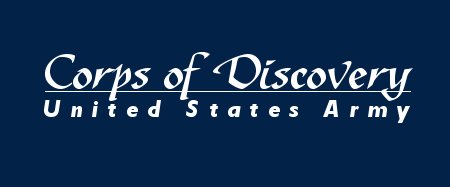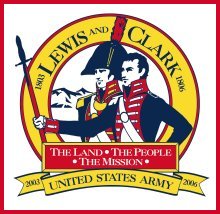
- Home
- Online Bookshelves
- Books and Research Materials
- Early National Era
- Corps of Discovery
 |
 |
|
|
“WE
FOUND IT EXCELLENT WHITE & FINE”: By Glenn F. Williams Today, many Americans do not stop to think how important salt is, or how much we take it for granted. For the members of the Corps of Discovery, facing hardship and privation far from the comforts of home on their cross-continent expedition, it was an important and valuable commodity. Orderly [First] Sergeant John Ordway attested to this when he sat down to Christmas dinner in 1805 at Fort Clatsop, and commented, “[W]e have nothing to eat but poore [sic] Elk meat and no Salt to Season that with.” [1] Salt
was not merely used as a seasoning, but in the days before canning and
refrigeration, it was a preservative. The men of the Corps did not consume
all the fish or meat of the animals they killed right away, but dried
some of it for consumption later. For that, they needed salt. An example
of salt’s importance surfaced early in the expedition. Fortunately, three
soldiers who were skilled in salt making, Privates Joseph and Reuben Field,
and William Werner, accompanied the expedition as it trekked westward
toward the On
a cloudy December 8, morning, while Captain William Clark led a five-man
detachment “on a Course S 60 W,” to reconnoiter the area and the best
route to the ocean, Captain Lewis sent out a detail of hunters to procure
fresh meat, and directed most of the others to fell trees for the construction
of a fort for winter quarters. By
December 28, On New Years Day of 1806, the captains began to feel “uneasy” about the failure of Willard and Weiser to return from the salt making camp. When they set out with the salt makers, the pair had been instructed to return immediately, but the officers reflected that “their not having returned induces us too believe it probable that they have missed their way.” [5] After an absence of five days, Lewis sent Sergeant Patrick Gass and Private George Shannon to find the salt making detail, “somewhere on the coast to the S W of us, to inquire after Willard and Wiser [sic] who have not yet returned.” [6]
Despite the concern, the men were safe. When Weiser and Willard arrived
back at
The salt makers and their helpers had “erected a comfortable camp,” and
killed an elk and several deer, thus securing a good store of meat for
their rations. After they finished building the
The next day, January 6, Sergeant Gass and Private Shannon, who had been
sent to find Willard and Wiser, arrived at the seaside camp, and discovered
“our salt makers at work.” He added that “Two of their detachment [Willard
and Wiser] had set out for the fort on the 4th and the man
that had come with me [Shannon] and two more went to hunt.”
[10] Four days later, while returning to It seemed, however, that game was not as plentiful near the salt makers’ camp as originally hoped. On January 25, Clark recorded, “[I]n the evening [Private John] Collins one of the Saltmakers returned and reported that they had made about one bushel of Salt and that himself and two others had hunted from the Salt Camp for five days without killing anything and they had been obliged to Subsist on Some whale which they purchased from the natives.” [12] The next morning, Lewis and Clark ordered Collins to return and rejoin the salt makers. They gave him “Some Small articles of Merchendize [sic] to purchase Some provisions from the Indians in the event of their Still being unfortunate in the chase.” [13]
Knowing theirs was a big job, in order for the salt makers to focus their
attention on the task throughout their stay on the coast, the officers
began regularly sending other soldiers to assist them with hunting game
and carrying the meat to their camp. About noon on the twenty-eighth,
after a delay caused by bad weather, Privates Thomas Howard and William
Werner returned to Clatsop with a supply of salt after helping the men
on the coast. Upon their return, they informed the captains that the
salt makers were “still much straightened for provisions, having killed
two deer only in the last six days.”
[14] Even more men were sent to assist with the hunting. One group
of four returned on the evening of February 3, to report that they had
assisted in carrying meat to the salt camp, and returned to
The lack of game was not the only hardship the salt makers faced. The
journal entries for February 10, 1806, recorded that, “Willard arrived
late in the evening from the Saltworks, had cut his knee very badly with
his tomahawk.” The soldier had managed to kill four elk not far from
the salt works two days before. After he had butchered and carried part
of the meat to camp, the injury prevented him from being of any further
use, and he returned to After three days, Pryor and his detachment had not yet returned, and the two captains began to worry once again about the delay. About 3 o’clock in the afternoon of February 15, Private Bratton arrived with word that Pryor’s detachment was at last on their way, carrying Gibson, “so much reduced that he can not stand alone,” on a litter. Although his appearance showed the effects of his illness, Bratton at least seemed to be getting better. When Pryor arrived after dark, Lewis and Clark were “much pleased in finding [Gibson] by no means as ill as we had expected.” Although suffering from a fever and “much reduced,” he appeared to be out of danger. The two captains believed that his illness “originated in a violent cold which he contracted in hunting and pursuing Elk and other game through the swam[p] and marshes about the salt works.” [18]
While Bratton and Gibson recovered from their illnesses, at 2:00 PM on
February 17, Private Joseph Fields arrived at
After being delayed for two days by rough water in the bay that prevented
them from passing the entrance, and paddling up the creek in their canoe,
Sergeant Ordway and his six men set out by land. Private Joseph Whitehouse
later described that the patrol could not proceed in the storm “without
suffering by the Sand blowing in our faces” and being pelted by freezing
rain. [20] The sergeant and his detail set out early on February 21
for the return to The effort to make salt during the winter of 1805-1806 on the Pacific coast provides us yet another example of the ingenuity and resourcefulness of the Soldiers of the Corps of Discovery. Privates Joseph and Reuben Field in particular applied the skills they learned in civilian life toward the accomplishment of their unit’s mission. Not unlike the Soldiers of today, the salt makers demonstrated adherence to the Army and Soldier Values, ingenuity and initiative, and contributed to the success of their unit’s mission. [1] Moulton, Gary ed., The Journals of the Lewis and Clark Expedition, Volume 9, The Journals of John Ordway, May 14, 1804 – September 23, 1806, and Charles Floyd, May 14 – August 18, 1804 (Lincoln, NE: University of Nebraska Press, 1995), 262. [2] Bergon, Frank ed., The Journals of Lewis and Clark (New York, NY: Penguin Books, 1989), 9. [3] Thwaites, Reuben Gold ed., Original Journals
of the Lewis and [4] Ibid 292-293. [5] Ibid 302. [6] Ibid 309. [7] Ibid 312-314. [8] Ibid 314. [9] Moulton, Gary ed., The Journals of the Lewis and Clark Expedition, Volume 11, The Journals of Joseph Whitehouse, May 14, 1804 – April 2, 1806 (Lincoln, NE: University of Nebraska Press, 1997), 410). [10] Moulton, Gary ed., The Journals of the Lewis and Clark Expedition, Volume 10, The Journal of Patrick Gass, May 14, 1804 – September 23, 1806 (Lincoln, NE: University of Nebraska Press, 1996), 187; MacGregor, Carol Lynn, The Journals of Patrick Gass: Member of the Lewis and Clark Expedition (Missoula, MT: Mountain Press Publishing Company, 1997), 162. [11] Thwaites, Reuben Gold ed., Original Journals
of the Lewis and [12] Thwaites, Reuben Gold ed., Original Journals
of the Lewis and [13] Ibid, 4: 14 [14] Ibid 4: 18, 20. [15] Ibid 4: 39-40. [16] Ibid 4: 57-58. [17] Ibid 4: 58-61. [18] Ibid 4: 68-70. [19] Ibid 4: 81, 83; Moulton, Gary ed., The Journals of the Lewis and Clark Expedition, 10: 193; MacGregor, Carol Lynn, The Journals of Patrick Gass, 165. [20] Thwaites, Reuben Gold ed., Original Journals of the Lewis and Clark Expedition 1804-1806, 4: 87-88; Moulton, Gary ed., The Journals of the Lewis and Clark Expedition, 11: 421. [21] Thwaites, Reuben Gold ed., Original Journals
of the Lewis and Clark Expedition, 4: 92, 94; Moulton,
|
||
